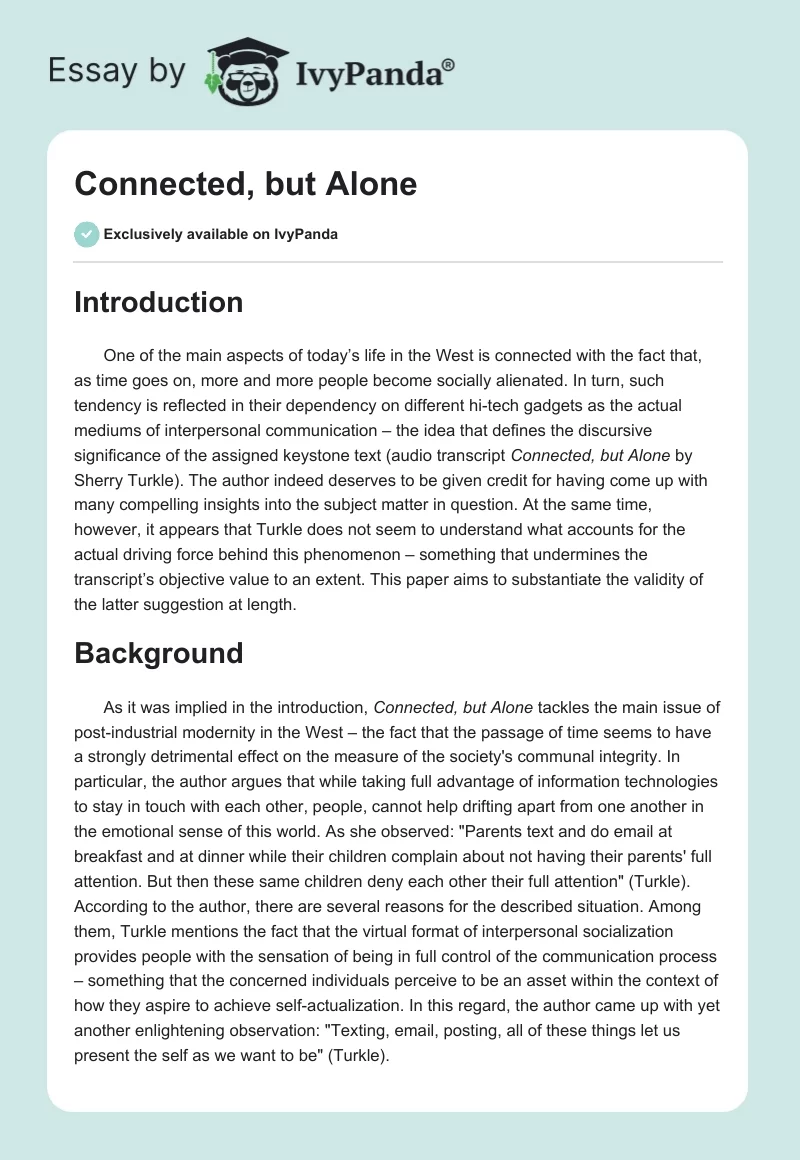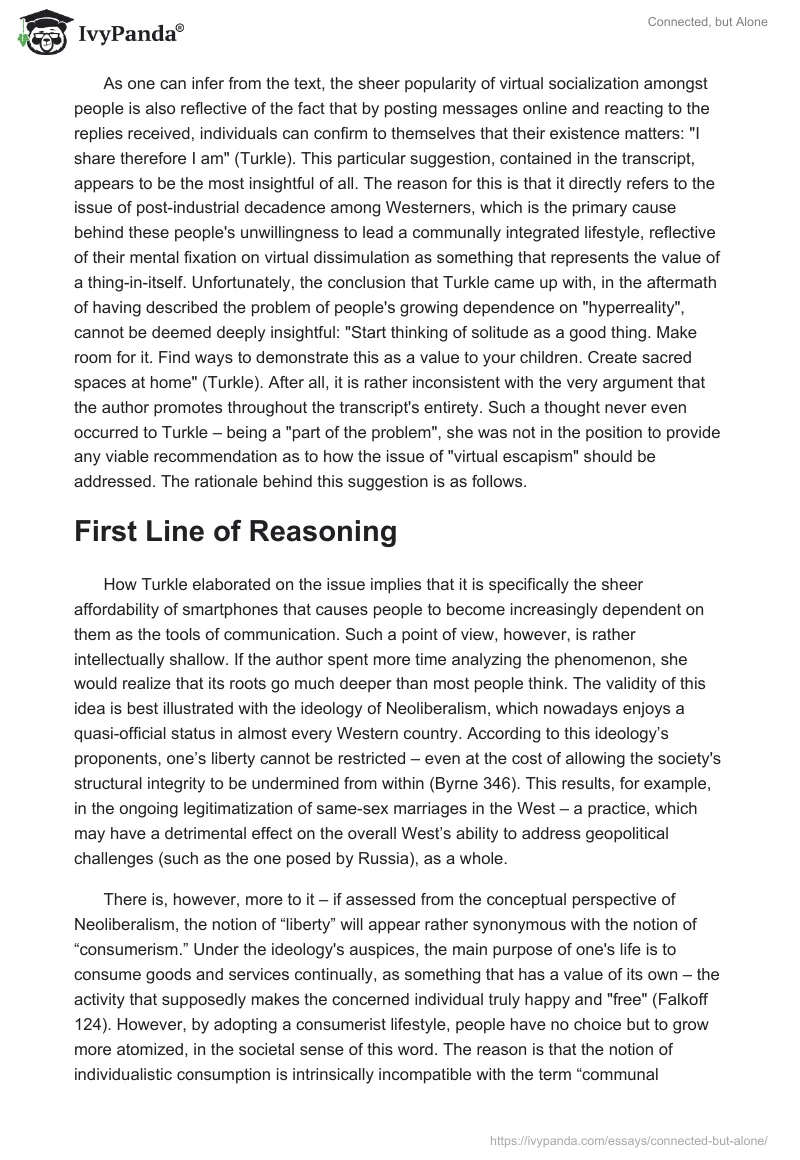Introduction
One of the main aspects of today’s life in the West is connected with the fact that, as time goes on, more and more people become socially alienated. In turn, such tendency is reflected in their dependency on different hi-tech gadgets as the actual mediums of interpersonal communication – the idea that defines the discursive significance of the assigned keystone text (audio transcript Connected, but Alone by Sherry Turkle). The author indeed deserves to be given credit for having come up with many compelling insights into the subject matter in question. At the same time, however, it appears that Turkle does not seem to understand what accounts for the actual driving force behind this phenomenon – something that undermines the transcript’s objective value to an extent. This paper aims to substantiate the validity of the latter suggestion at length.
Background
As it was implied in the introduction, Connected, but Alone tackles the main issue of post-industrial modernity in the West – the fact that the passage of time seems to have a strongly detrimental effect on the measure of the society’s communal integrity. In particular, the author argues that while taking full advantage of information technologies to stay in touch with each other, people, cannot help drifting apart from one another in the emotional sense of this world. As she observed: “Parents text and do email at breakfast and at dinner while their children complain about not having their parents’ full attention. But then these same children deny each other their full attention” (Turkle). According to the author, there are several reasons for the described situation. Among them, Turkle mentions the fact that the virtual format of interpersonal socialization provides people with the sensation of being in full control of the communication process – something that the concerned individuals perceive to be an asset within the context of how they aspire to achieve self-actualization. In this regard, the author came up with yet another enlightening observation: “Texting, email, posting, all of these things let us present the self as we want to be” (Turkle).
As one can infer from the text, the sheer popularity of virtual socialization amongst people is also reflective of the fact that by posting messages online and reacting to the replies received, individuals can confirm to themselves that their existence matters: “I share therefore I am” (Turkle). This particular suggestion, contained in the transcript, appears to be the most insightful of all. The reason for this is that it directly refers to the issue of post-industrial decadence among Westerners, which is the primary cause behind these people’s unwillingness to lead a communally integrated lifestyle, reflective of their mental fixation on virtual dissimulation as something that represents the value of a thing-in-itself. Unfortunately, the conclusion that Turkle came up with, in the aftermath of having described the problem of people’s growing dependence on “hyperreality”, cannot be deemed deeply insightful: “Start thinking of solitude as a good thing. Make room for it. Find ways to demonstrate this as a value to your children. Create sacred spaces at home” (Turkle). After all, it is rather inconsistent with the very argument that the author promotes throughout the transcript’s entirety. Such a thought never even occurred to Turkle – being a “part of the problem”, she was not in the position to provide any viable recommendation as to how the issue of “virtual escapism” should be addressed. The rationale behind this suggestion is as follows.
First Line of Reasoning
How Turkle elaborated on the issue implies that it is specifically the sheer affordability of smartphones that causes people to become increasingly dependent on them as the tools of communication. Such a point of view, however, is rather intellectually shallow. If the author spent more time analyzing the phenomenon, she would realize that its roots go much deeper than most people think. The validity of this idea is best illustrated with the ideology of Neoliberalism, which nowadays enjoys a quasi-official status in almost every Western country. According to this ideology’s proponents, one’s liberty cannot be restricted – even at the cost of allowing the society’s structural integrity to be undermined from within (Byrne 346). This results, for example, in the ongoing legitimatization of same-sex marriages in the West – a practice, which may have a detrimental effect on the overall West’s ability to address geopolitical challenges (such as the one posed by Russia), as a whole.
There is, however, more to it – if assessed from the conceptual perspective of Neoliberalism, the notion of “liberty” will appear rather synonymous with the notion of “consumerism.” Under the ideology’s auspices, the main purpose of one’s life is to consume goods and services continually, as something that has a value of its own – the activity that supposedly makes the concerned individual truly happy and “free” (Falkoff 124). However, by adopting a consumerist lifestyle, people have no choice but to grow more atomized, in the societal sense of this word. The reason is that the notion of individualistic consumption is intrinsically incompatible with the term “communal solidarity,” which presupposes people’s willingness to share valuable resources and accounts for the foremost principle of the society’s proper functioning (Twenge 18). As a result, more and more Westerners turn into socially withdrawn and selfish hedonists, preoccupied with trying to satisfy their animalistic instincts – the activity inconsistent with these people’s formal status of socially integrated beings (Plattner 7). This may be the actual reason behind the ongoing deterioration of the sense of social empathy in people and not merely the increased availability of smartphones, as Turkle states.
Second Line of Reasoning
Another reason why Turkle’s conclusion can be doubted as the one representing an undisputable truth-value is connected with the universalist sounding of many of her observations. This particular quality of the author’s speech, however, appears to be uncalled for. After all, as sociologists are well aware, the phenomenon of more and more people “resettling” into the virtual realm has a distinctive “colour” to it. That is, the issue concerns Whites predominantly, with the representatives of racial minorities in the West being largely unaffected by it (Cyr et al. 87).
This does not suggest that the latter take advantage of modern communication technologies to any lesser extent than the former. However, as practice indicates, for as long as ethnically visible citizens are concerned, their communicative dependence on hi-tech gadgets does not result in causing these individuals to be less committed to professing family values (Kim and Raley 142). Moreover, it does not prompt them to act in a socially escapist manner, as is often the case with Whites. To confirm the validity of this statement, one could take a short trip to any suburban ethnic ghetto in the US or UK. Being a career-focused White urbanite, Turkle assessed the issue of “virtual dissimulation” from her existential perspective. This alone implies that the author’s recommendation, as to how the discussed phenomenon should be dealt with, can not be considered fully applicable, in the societal sense of this word.
Conclusion
In light of what has been mentioned earlier, there can be little doubt as to the soundness of the paper’s initial thesis that the transcript Connected, but Alone is best seen as being both enlightening and short-sighted at the same time – whatever paradoxical this may sound. After all, Turkle succeeded in identifying the issue of concern and describing its socially observable extrapolations. Nevertheless, the author also exhibited a certain inability to look beyond these extrapolations while striving to grasp the actual essence of how information technologies affect people’s perception of the surrounding social reality and their place in it. One of the possible explanations, in this respect, is that Turkle is a journalist and one’s journalistic opinions have never been considered particularly valuable, especially when the discussion of the systemically complex social issues is being concerned. This, however, does not mean that the Connected, but Alone transcript should not be recommended for reading, given the fact that the author’s understanding of the problem of “digital alienation” correlates well with unconscious anxieties in the targeted audience.
Works Cited
Byrne, Christopher. “Neoliberalism as an Object of Political Analysis: An Ideology, a Mode of Regulation or a Governmentality?” Policy and Politics, vol. 45, no. 3, 2017, pp. 343-360.
Cyr, Betty-Ann, et al. “The Role of Communication Technology in Adolescent Relationships and Identity Development.” Child & Youth Care Forum, vol. 44, no. 1, 2015, pp. 79-92.
Falkoff, Rebecca. “The Practice of Misuse: Rugged Consumerism in Contemporary American Culture.” Configurations, vol. 23, no. 1, 2015, pp. 123-131.
Kim, Yujin, and Raymond Raley. “Race-Ethnic Differences in the Marital Fertility Rates in 2006-2010.” Population Research and Policy Review, vol. 34, no. 1, 2015, pp. 141-159.
Plattner, Marc. “Liberal Democracy’s Fading Allure.” Journal of Democracy, vol. 28, no. 4, 2017, pp. 5-14.
Turkle, Sherry. “Connected, but Alone?”TedTalks. 2012, Web.
Twenge, Jean. “Does Online Social Media Lead to Social Connection or Social Disconnection.” Journal of College and Character, vol. 14, no. 1, 2013, pp. 11-20.


